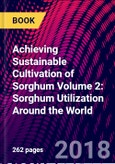Audience: Cereal scientists; sorghum breeders and growers; government and non-government agencies supporting sorghum cultivation
Table of Contents
Part 1 Sorghum utilization1. Structure and chemistry of sorghum grain: S. R. Bean, B. P. Ioerger , J. D. Wilson , M. Tilley , D. Rhodes and T. J. Herald , USDA-ARS, USA;
2. The domestication, spread and uses of sorghum as a crop: F. M. Shapter, A. Crowther, G. Fox, I. D. Godwin and L. Watson-Fox, University of Queensland, Australia; I. J. C. Hannah, AGR Industries, Australia; and S. L. Norton, Agriculture Victoria, Australia;
3. Growth, development and physiology of grain sorghum: M. Djanaguiraman, P. V. V. Prasad and I. A. Ciampitti, Kansas State University, USA;
4. Sorghum as a food grain: Barbara J. Stoecker, Oklahoma State University, USA; Kebede Abegaz, Hawassa University, Ethiopia; and Yewelsew Abebe, Alive and Thrive, Ethiopia;
5. Sorghum as a forage and energy crop: Scott Staggenborg and Hui Shen, Chromatin Inc., USA;
Part 2 Sorghum production and improvement across the world
6. Introducing new technologies and market strategies for sorghum producers in developing countries: the Sahel case: John H. Sanders, Purdue University, USA; Botorou Ouendeba, former Director of the 3N Program, Niger; Ababacar Ndoye, former Director of the Institute of Food Technology, Senegal; and Niaba Témé, Institute of the Agricultural Economy (IER), Mali;
7. Improving sorghum cultivation in South America: Rafael Augusto da Costa Parrella, Robert Eugene Schaffert, Cicero Bezerra de Menezes, José Avelino Santos Rodrigues, Jurandir Vieira Magalhães, Cynthia Maria Borges Damasceno, Dagma Dionísia da Silva and Simone Martins Mendes, Embrapa Milho e Sorgo, Brazil;
8. Improving production and utilization of sorghum in Asia: Aruna C., B. Dayakar Rao, Vilas A. Tonapi and T. G. Nageshwar Rao, Indian Institute of Millets Research, India;
9. Sorghum cultivation and improvement in West and Central Africa: E. Weltzien and H. F. W. Rattunde, University of Wisconsin-Madison, USA, formerly International Crop Research Institute for the Semi-Arid Tropics (ICRISAT), Mali; T. A. van Mourik, International Potato Center, Ghana; and H. A. Ajeigbe, International Crop Research Institute for the Semi-Arid Tropics (ICRISAT), Nigeria








